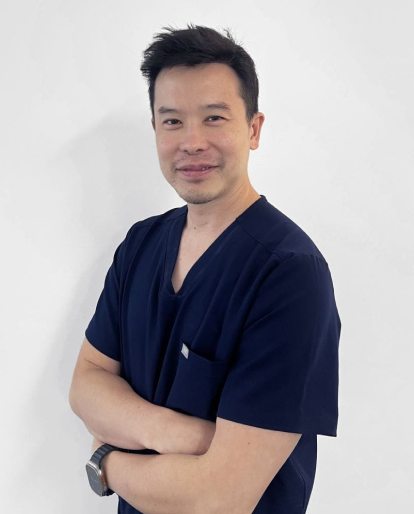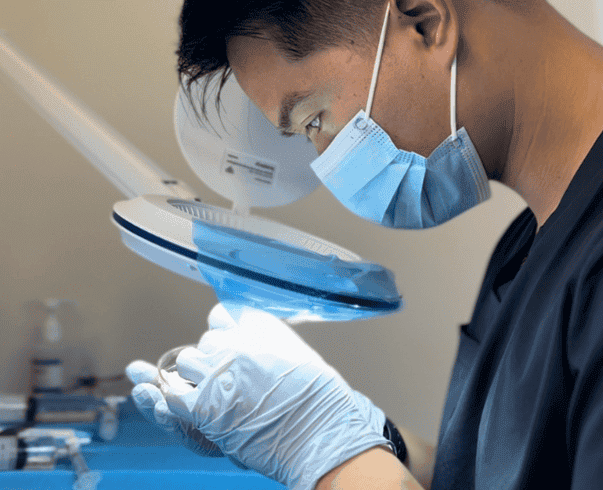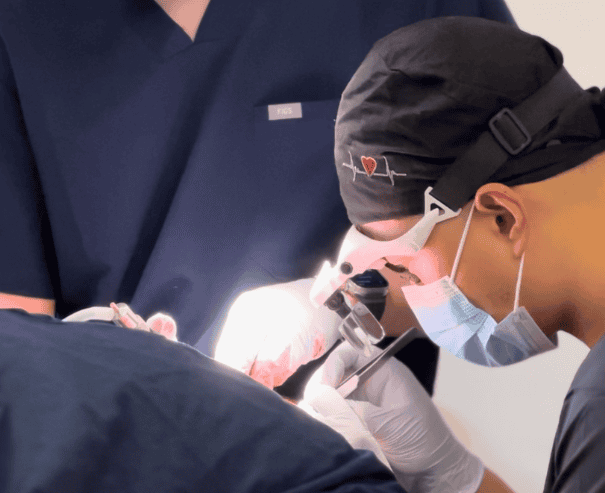Precision and Results with FUE Hair Transplants
At FUE Clinics, we focus on Follicular Unit Extraction (FUE) hair transplants — an innovative hair transplant procedure designed to address various forms of hair loss, including male and female pattern baldness, as well as thinning hair resulting from lifestyle or natural factors.
Unlike Follicular Unit Transplantation (FUT), which involves removing a strip of scalp to harvest hair follicles and can result in a linear scar, the FUE procedure transplants individual hair follicles from areas with healthy growth (typically the back and sides of the scalp) to regions experiencing thinning. Each hair graft is selected and positioned with precision, promoting a natural-looking outcome.
FUE techniques also avoid the need for large incisions or stitches, allowing for a quicker recovery period and minimal visible scarring. Proper technique in handling hair grafts is crucial for their long-term survival and achieving the desired aesthetic results. Our commitment to meticulous care and tailored solutions distinguishes FUE Clinics when it comes to hair restoration.
-
 Hair transplants starting from $7,995
Hair transplants starting from $7,995
-
 Perth-based Doctors
Perth-based Doctors
-
 Free consultations
Free consultations
-
 Over 25 years experience
Over 25 years experience
Meet Dr. TJ
Dr. TJ graduated from the University of Queensland in 2009 and has over a decade of experience in Minor Surgery and Aesthetic Medicine. He has transplanted in excess of over 6 million hairs over 1500 hair transplant procedures in 7 years, making him one of the most experienced Hair Transplant Doctors in the country. He received his credentials from the London Hair Restoration Academy and has operated across Australia and New Zealand, including Perth, Sydney, Brisbane, Melbourne, and Auckland. Additionally, he has contributed to training many doctors in Australia and New Zealand.
Dr. TJ is an expert in Micro FUE extraction and DHI implantation. He is dedicated to achieving the best possible outcome for every patient, tailored to their specific needs and challenges.
Dr. TJ is also a published author in journals covering Oncology, Skin Medicine, and Radiology.


FUE Hair Transplant Costs
Typically, costs start from $7995, with an average cost around $13,000 (subject to the number of grafts required).
Our doctors are able to transplant in excess of 4000 grafts (10,000 hairs) in a single day and 6000 grafts (14,000 hairs) over two days.
We offer complimentary consultations with our medical team and during which will will provide a clear cost outline and discuss all finance options, helping you make a considered decision.

Our FUE Hair Transplant Procedure
At FUE Clinics, each step of the FUE process is structured to provide a supportive experience and a natural-looking outcome:
Consultations, Assessment and Pre-Procedure
Preparing for an FUE hair transplant involves several important steps to ensure the best possible outcome. At FUE Clinics, this begins with a thorough consultation with a qualified hair transplant expert. During this consultation, the team will place your scalp/follicles under magnification to accurately determine your groupings and donor area capabilities. We will only quote/determine a plan based on what the client’s donor area can provide.
Patients are also provided with pre-procedure instructions to follow. These guidelines may include recommendations on medication, diet, and lifestyle modifications to prepare your body for the procedure and promote optimal healing.
Preparation and Anaesthesia
On the day of the procedure, the hair in the donor area is trimmed short. This step is crucial as it facilitates the extraction of individual hair follicles. Local anaesthesia is then administered to the donor area to numb it, ensuring that you remain comfortable throughout the extraction process.
Follicular Unit Extraction and DHI with Choi Implanters
Extraction and placement start with the preparation of the donor area, where individual hair follicles are meticulously extracted using specialised tools to minimise scarring and maximise graft quality. Once prepared, the scalp region is treated with tiny incisions where each implanted hair follicle is implanted with precise control over angle, depth, and direction.
The follicles are naturally held in place by the surrounding tissue once implanted, which provides an initial level of stability. During the healing process, tiny blood clots form around each follicle, helping to hold them into position. Over the next few days, as the scalp heals, the skin begins to anchor the follicles more securely. There’s no need for sutures; rather, the body’s natural healing processes effectively secure the grafts in place, enabling them to integrate and grow as part of the natural hairline.
Aftercare, Recovery, and Long-Term Results
Post-procedure, we provide personalised aftercare guidance and follow-up support to promote smooth recovery and optimal results.
Recovering from FUE is generally straightforward, with mild swelling and some scabbing expected as part of the healing process. With advancements in hair transplant techniques, recovery times are now typically shorter, and many patients resume regular activities within days.
Transplanted hair is generally shed as part of the natural hair cycle, with new growth generally beginning within three to four months and full results visible in approximately nine to twelve months. Treatments like stem cell therapy and PRF can promote hair growth and improve hair density.

Why Choose FUE Clinics for an FUE Hair Transplant
At FUE Clinics, our approach combines advanced techniques with a focus on each patient’s specific needs. As previously noted, we offer a complimentary, in-person consultation with our hair care team to assess your hair goals and provide expert guidance on your options.
FUE Clinics’ method of follicle extraction and placement uses precise, minimally invasive techniques that support a natural result without visible scarring. With the capacity to relocate up to 4000 grafts/follicles in one day (this is just shy of 10,000 hairs) follicles in a single session, FUE Clinics achieves a fuller look that aligns with each individual’s hairline. Throughout the entire process, our team is committed to clear communication, support, and guidance to ensure a comfortable experience from start to finish.
Benefits of FUE Hair Transplant
Opting for an FUE hair transplant comes with a multitude of benefits, making it a preferred choice for those seeking effective hair restoration. One of the standout advantages is that FUE is a minimally invasive procedure. This means less trauma to the scalp and a significantly reduced risk of complications compared to traditional methods.
Another key benefit is natural-looking results. FUE allows for the precise placement of individual hair follicles, ensuring that the transplanted hair blends seamlessly with your existing hair.
Scarring is a common concern with hair transplants, but FUE addresses this effectively. The procedure leaves tiny, virtually undetectable scars, making it an attractive option for those worried about visible scarring. Additionally, the recovery time with FUE is shorter, allowing most patients to resume light activities within a few days.
FUE also offers flexibility, as it can be used to transplant hair to various areas of the body, including the scalp, eyebrows, and beard. This versatility makes FUE a comprehensive solution for hair restoration needs.


Ideal Candidates for FUE Hair Transplantation
FUE hair transplantation is well-suited for individuals with a healthy supply of donor hair and is effective for addressing both small and more extensive areas of thinning. Individuals with a receding hairline, thinning crown, or other specific areas of hair loss may benefit particularly from FUE, as it provides a naturally dense look.
This method is also ideal for those who prefer shorter hairstyles, as the tiny circular scars created by FUE fade over time. Additionally, individuals with tighter scalps who may not suit other techniques often find FUE to be an adaptable choice.
Book Your FUE Hair Transplant Consultation Today
At FUE Clinics, we are committed to delivering high-quality results with an emphasis on patient comfort and personalised care.
If you are considering an FUE hair transplant, we invite you to book a complimentary in-person consultation at our Perth clinic. Our team is here to assess your hair restoration needs, provide guidance on your options, and design a plan tailored to your goals.

FUE Hair Transplant FAQ
Your Title Goes Here
Your content goes here. Edit or remove this text inline or in the module Content settings. You can also style every aspect of this content in the module Design settings and even apply custom CSS to this text in the module Advanced settings.
Is a FUE hair transplant painful?
The FUE procedure is performed under local anaesthesia, ensuring minimal discomfort during the procedure. Patients may experience mild soreness or tightness in the donor and recipient areas post-procedure. Any discomfort typically subsides within a few days and can be managed with over-the-counter or prescribed pain relievers.
Is medication necessary after an FUE hair transplant?
Why is FUE better than FUT?
Can you be too bald for a FUE hair transplant?
Yes, FUE requires a sufficient amount of healthy donor hair, usually from the back or sides of the scalp. If a patient has advanced baldness with minimal donor hair, a transplant may not be viable, or results may appear unnatural. In such cases, alternative treatments like scalp micropigmentation, PRP therapy, or hair systems may be more suitable. A Hair Transplant Doctor can determine candidacy based on donor hair availability and the desired coverage.
When can I wear a hat after a FUE hair transplant?
How long before I can start sleeping normally?
Fill out the form below for an obligation free quote!
Our team is here to assist you with any questions about hair restoration, the FUE process, or to schedule your consultation. We look forward to offering you the very best in hair restoration, from initial contact through to successful treatment outcomes.
